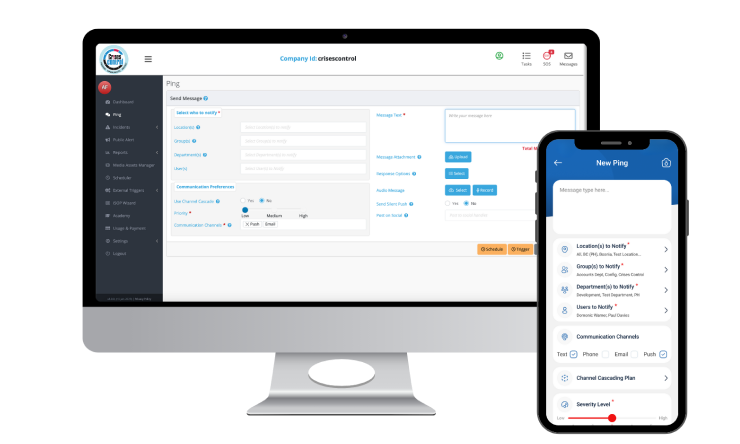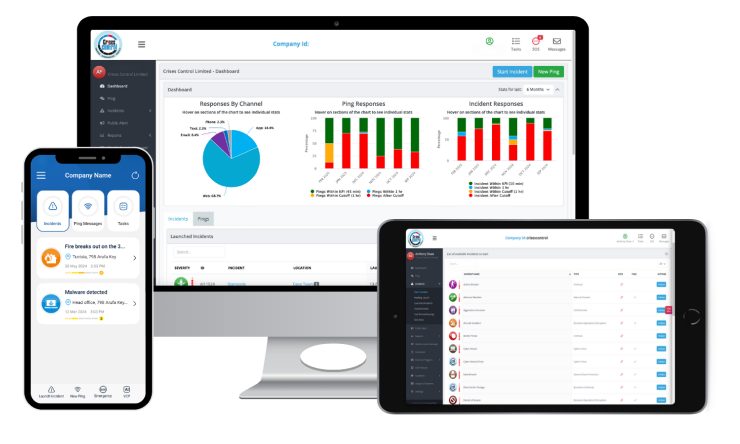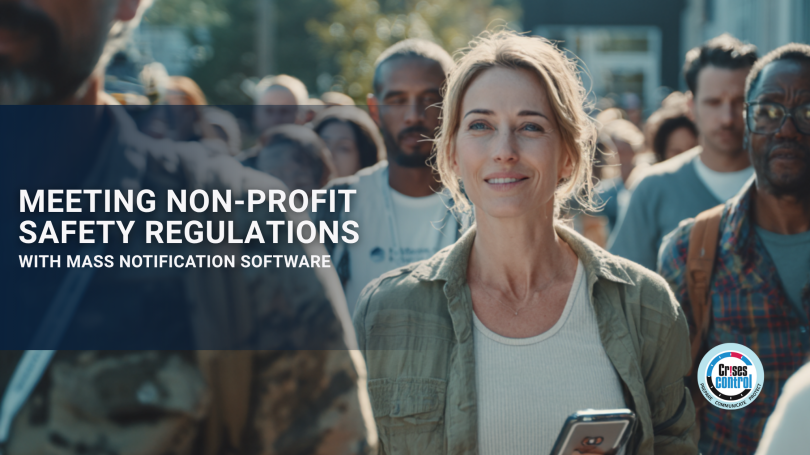Written by Anneri Fourie | Crises Control Executive
In many non-profit organisations, safety planning is often overshadowed by the day-to-day pressures of delivering services. Teams are focused on community impact, fundraising, and service delivery. What often gets overlooked is how quickly a small incident can spiral into a major emergency. A power cut, security threat, fire, or even a lost child can put people at risk, disrupt operations, and create serious compliance issues if the organisation cannot prove how it responded.
This is not just about operational readiness. Non-profits have a legal and ethical duty to protect their people. Regulators expect organisations to have the right processes in place to alert staff quickly, document what happened, and show that they took the right action. This is where Mass Notification Software can transform how non-profits handle emergencies. By improving communication and record keeping, it helps organisations meet safety regulations while protecting employees, volunteers and the communities they serve.
Understanding Non-Profit Safety Regulations
Non-profit organisations are bound by many of the same health and safety laws as other employers. Whether they run a single centre or operate across several regions, they are responsible for keeping people safe. This responsibility applies to employees, volunteers, service users, and sometimes members of the public.
Although specific regulations differ from country to country, the key expectations are similar. Non-profits must be able to:
- Keep staff safe during emergencies.
- Communicate clearly and quickly when incidents happen.
- Maintain accurate records of emergency reporting and responses.
- Test their business continuity plans regularly.
These rules are not just there to satisfy auditors. They exist to protect lives and limit the impact of disruptions. In practice, this means that an organisation must be able to prove how it managed an incident. Who was notified? When were they notified? How did they respond?
Traditional communication tools like group emails or phone chains are often too slow and unreliable in emergencies. They leave gaps, make tracking difficult and create more risk than assurance. Mass Notification Software gives non-profits a faster, more structured way to meet these obligations.
How Mass Notification Software Supports Regulatory Compliance
Real-time alerts during emergencies
One of the biggest expectations regulators have is that organisations can send clear alerts quickly. Mass notification platforms make this possible. They send messages through multiple channels at once, including text, email, voice, push notifications and desktop alerts. This ensures that no one is missed.
When emergencies happen, time spent chasing people can increase risk. A well-planned alerting system allows a message to be sent to everyone who needs it in seconds. It also records who received the message, who opened it and who responded. This gives compliance teams the proof they need later on.
A clear incident reporting system
Another key requirement is being able to show exactly how an organisation managed an incident. Mass notification systems log every alert, acknowledgement, escalation and follow-up action automatically. These records can be stored securely and used as evidence during audits, investigations or internal reviews.
For non-profits that work in high-risk areas or care for vulnerable people, this level of transparency is crucial. It protects both the organisation and the people they serve.
Meeting duty of care obligations
Duty of care is not just a legal requirement; it’s a matter of trust. Staff, volunteers and service users rely on organisations to keep them informed and safe. Mass notification tools support this by allowing teams to send alerts that can also collect responses.
For example, during a flood or a security alert, the system can ask staff to confirm if they are safe. This makes it easier to identify who might need help and where resources should go. It turns communication into a two-way process that builds confidence and accountability.
Key Emergency and Safety Requirements Under Non-Profit Safety Regulations
Regulatory inspections often focus on specific operational areas. These are common requirements where a mass notification system can help:
Crisis communication
Non-profits must show that they can communicate rapidly during emergencies. Automated alerts, pre-built templates and location targeting make this easier.
Emergency reporting
Clear records of messages, acknowledgements and timelines allow organisations to show what was done and when.
Employee safety protocols
Real-time alerts support evacuation, lockdown and other protective actions.
Preparedness testing
Regular system testing and drills demonstrate readiness, which can be required by insurers and regulators.
Scalability and accessibility
Many non-profits operate across multiple sites. A single alerting system ensures messages are delivered consistently and accurately to everyone who needs them.
Real-World Scenarios Where Mass Notification Software Supports Non-Profit Safety Regulations
Non-profits operate in diverse settings, from humanitarian projects abroad to local community centres. Risks can appear quickly and without warning. A reliable communication system makes it possible to respond in a structured way and record what happens.
Here are some examples of real scenarios where communication speed and clarity are critical:
- Security incidents: Lockdowns triggered by vandalism, threats or nearby criminal activity.
- Environmental emergencies: Floods, fires, or severe weather affecting buildings and operations.
- Operational disruptions: Power failures, IT outages or transport issues.
- Welfare incidents: Missing children, vulnerable adults needing support or medical emergencies.
In each case, an organisation must respond fast, keep people informed and later provide evidence of what it did. A structured incident reporting system supports all three.
Why Manual Communication Methods Are Not Enough
Many non-profits still rely on manual methods like phone chains or email lists. While familiar, these tools can quickly become unreliable during high-pressure situations. Common problems include:
- Slow delivery: Messages are sent one by one, causing delays.
- No clear records: There is no easy way to prove who was contacted or when.
- Human error: Critical information can be sent to the wrong person or forgotten entirely.
- Limited reach: Not everyone is on email or available by phone when incidents happen.
Regulators expect organisations to have stronger systems in place. A mass notification platform removes these weak points and replaces them with a faster, more reliable process that is easy to prove after an event.
How Crises Control Helps Non-Profits Meet Compliance
Crises Control offers a Ping Mass Notification module designed to support non-profits with both operational response and regulatory compliance. It helps organisations issue fast alerts, track acknowledgements, and maintain clear records of every communication.
Key features include:
- Multi-channel delivery through SMS, Email, Voice, Push Notifications and Desktop Alerts.
- Pre-configured templates for common incidents such as lockdowns, fire alerts and missing persons.
- Automatic logging and reporting, making regulatory audits simpler.
- Two-way communication so staff can confirm receipt and provide status updates.
- Geolocation targeting to ensure alerts reach the right people.
- Testing and simulation features to support regular compliance checks.
These capabilities give non-profits a practical and measurable way to meet safety regulations and duty of care responsibilities.
Benefits Beyond Compliance
While meeting regulations is essential, mass notification systems bring wider benefits that strengthen operations:
- More confident teams: People feel safer when they know they’ll be informed quickly.
- Greater trust: Non-profits that manage incidents well build stronger credibility with donors, regulators and communities.
- Better continuity: Fast communication reduces downtime and disruption.
- Less administration: Automated reporting replaces manual paperwork.
- Faster decision making: Real-time updates help leaders allocate resources effectively.
These benefits make mass notification technology not just a compliance tool, but a practical investment in resilience.
Integrating Mass Notification with Incident Reporting Systems
Many non-profits already have systems for business continuity or incident reporting. Crises Control can be integrated so that alerts and reports are all managed in one place. This removes the need to juggle multiple platforms and reduces the chance of information slipping through the cracks.
Here’s how it works in practice:
- When an incident happens, alerts can be sent from pre-built templates.
- Messages are delivered to the right groups instantly.
- Staff confirm receipt or provide updates in real time.
- A complete record of activity is created automatically.
This process gives organisations confidence during an incident and reassurance during later reviews or audits.
Preparing for Regulatory Scrutiny
Audits and inspections often focus on whether organisations can show how they handled incidents. Having a record of every alert, response and action taken makes this much simpler.
With Crises Control, non-profits can:
- Export clear communication records.
- Demonstrate testing schedules and readiness.
- Show evidence of acknowledgements and escalations.
- Provide clear accountability at each stage.
This preparation not only reduces the stress of inspections but also helps build a stronger safety culture across the organisation.
Interested in our Ping Mass Notification Software?
Efficiently alert everyone in seconds at scale with our Mass Notification Software.

Building a Culture of Safety in the Non-Profit Sector
Safety is more than a box to tick on a compliance checklist. For non-profits, it reflects the trust placed in them by staff, volunteers, funders and the communities they support.
Mass notification tools make safety planning part of everyday practice. They give teams the ability to communicate clearly, act quickly and prove what they did afterwards. This creates a stronger culture of safety, improves operational resilience and helps protect reputation.
Take the First Step Toward Stronger Compliance
Regulations around non-profit safety continue to develop. Expectations around speed, accuracy and transparency are getting higher. Mass Notification Software gives organisations the tools they need to keep people safe and meet their legal obligations with confidence.
Crises Control works with non-profits around the world, helping them to build reliable emergency communication strategies. Whether managing a major incident or running a routine test, our Ping module supports fast, clear and compliant communication.
If your organisation needs a reliable way to meet safety regulations and improve emergency reporting, we can help.
Contact us today to book a free demo and see how Crises Control can support your organisation.
Request a FREE Demo

